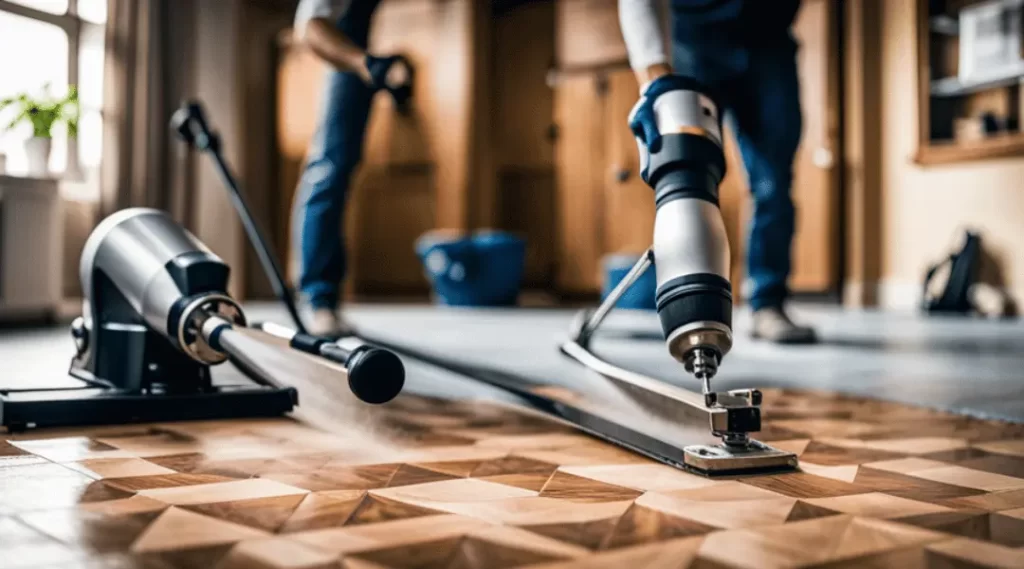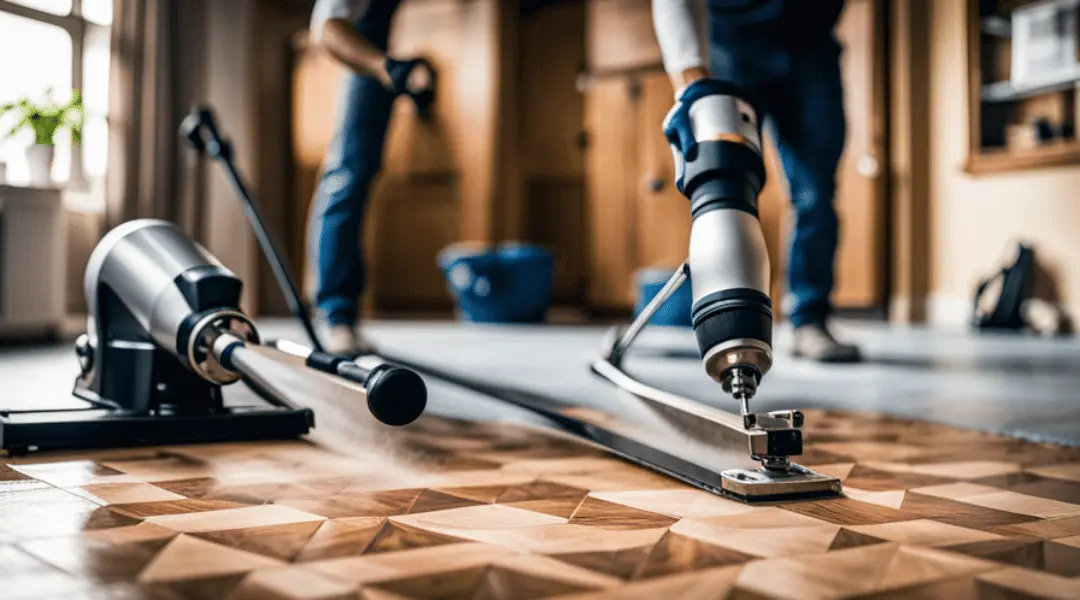Linoleum flooring is a popular choice among homeowners due to its affordability, durability, and ease of maintenance. However, over time, linoleum can become worn, stained, or outdated, prompting homeowners to remove it and replace it with a more modern flooring option.
The process of removing glued linoleum can be a daunting task, as it often leaves behind a stubborn adhesive residue that can be difficult to remove. Fortunately, there are several methods for safely removing glued linoleum from floors without leaving residue behind.
As with any home improvement project, preparation is key to ensuring a successful outcome. Before attempting to remove glued linoleum, it is essential to gather the necessary tools and materials, including a floor scraper, heat gun, adhesive solvent, protective gloves, and eye goggles.
Once you have assembled the necessary items, it is important to prepare the working area by removing any furniture or fixtures that may obstruct your movement and covering nearby surfaces with protective plastic sheeting. By taking these preliminary steps, you can ensure a safe and efficient removal process that will leave your floors looking clean and residue-free.
Gather the Necessary Tools and Materials

To successfully complete the task of separating linoleum from a surface, it is essential to gather all necessary tools and materials beforehand.
One of the most important things to consider is the type of adhesive used to attach the linoleum to the floor. Avoid using adhesives that are known to leave residue behind, such as rubber-based or contact adhesives. Instead, opt for water-based or solvent-based adhesives that are easier to remove.
Cost-effective alternatives to traditional adhesive removers include vinegar, baking soda, and hot water.
Additionally, you will need a scraper, a putty knife, a heat gun, a floor scraper, and safety equipment such as gloves and goggles.
Once you have gathered all the necessary tools and materials, you can proceed to prepare the working area.
Prepare the Working Area
Prior to beginning the linoleum removal process, it is important to prepare the working area to ensure a successful outcome and minimize any potential complications.
This involves measuring the space to be worked on and gathering all the necessary tools and materials.
Next, protect the surrounding surfaces by covering them with drop cloths or plastic sheeting. This will prevent any damage or debris from the removal process from spreading to other areas.
Additionally, ensure that the working area is well-ventilated to prevent the buildup of fumes from any chemicals used in the process.
By taking the time to properly prepare the working area, you can ensure that the linoleum removal process is safe and efficient.
Softening the adhesive will be the next step in the process to remove the linoleum without leaving residue behind.
Soften the Adhesive
The next step in the linoleum removal process involves softening the adhesive to facilitate its separation from the subfloor, ensuring a successful and efficient removal.
There are two common methods for softening the adhesive: chemical alternatives and heat application.
Chemical alternatives, such as adhesive removers and solvents, work by breaking down the adhesive’s bonds, making it easier to scrape off. However, it’s essential to choose a non-toxic solution and follow the manufacturer’s instructions carefully to avoid damaging the floor or creating a hazardous environment.
Heat application, on the other hand, involves using a heat gun or hairdryer to warm up the adhesive, causing it to soften and become less sticky. This method is ideal for small areas or when working with delicate subfloors that can’t withstand chemical solutions.
Whichever method you choose, it’s crucial to ensure that the adhesive is soft enough to scrape off without damaging the subfloor.
Transitioning into the next section, once the adhesive has softened, it’s time to scrape off the linoleum carefully.
Scrape off the Linoleum
When it comes to removing linoleum, using a scraper is an effective method to get the job done.
It is important to work in small sections to avoid damaging the subfloor and to make the process more manageable.
Once the linoleum is removed, any remaining adhesive should be removed as well to ensure a clean surface for future flooring installation.
Use a Scraper
Employing a scraper tool is a viable approach in the elimination of adhesive linoleum from a surface. Proper technique and safety precautions should be taken when using a scraper on linoleum removal. It is important to wear protective gloves and eyewear to prevent injury.
Additionally, the scraper should be held at a 45-degree angle to the surface to avoid damage. When using the scraper, it is important to work in small sections to prevent the adhesive from hardening and becoming more difficult to remove.
Alternative methods, such as heat or chemical solutions, for removing glued linoleum can also be used in conjunction with the scraper. By following these steps, the linoleum can be removed safely and efficiently without leaving residue behind.
Work in Small Sections
Efficient removal of adhesive linoleum from a surface can be achieved by working in small sections, which prevents the adhesive from hardening and becoming more difficult to remove.
Breaking down the task into small sections allows for a more manageable and focused approach, enabling the adhesive to be tackled effectively without spreading it across a larger area.
This technique is especially important when dealing with larger areas or when time is limited, as it allows for a more efficient and organized process.
Working in small sections also ensures that any mistakes or missed spots can be easily spotted and corrected before moving on to the next section.
It is important to note that the size of the sections should be determined by the individual’s capabilities and the size of the space being worked on.
Once the linoleum has been removed, it is crucial to remove any remaining adhesive to ensure a smooth surface for future use.
Remove Any Remaining Adhesive
It is imperative to thoroughly eliminate any lingering adhesive residue after the linoleum has been stripped away, in order to ensure a polished and professional finish that will leave a lasting impression.
Chemical alternatives are available to remove adhesive residue, but it is important to consider their environmental impact.
For a more eco-friendly approach, natural options like vinegar or baking soda mixed with warm water can be effective.
However, it is important to note that these natural alternatives may require a bit more elbow grease and time to fully remove the adhesive.
Once the adhesive has been removed, it is time to move on to the next step of cleaning the floor, which will ensure a smooth and level surface for any future flooring installations.
Clean the Floor
The area where the linoleum was previously attached should be thoroughly cleaned, using a mop and bucket with a suitable cleaning solution, to ensure a smooth and debris-free surface for the next flooring installation.
One of the most effective ways to clean the floor is by using a steam cleaner, which not only removes dirt and grime but also sanitizes the surface.
Alternatively, natural cleaning solutions such as vinegar and baking soda can be used to dissolve any remaining adhesive without damaging the floor.
It is important to remove any leftover residue or adhesive from the floor to avoid any issues with the new flooring installation.
After cleaning, inspect the floor for any remaining debris or damage before proceeding with the next steps.
Inspect the Floor
A thorough inspection of the floor is necessary at this stage to ensure that it is free from any remaining debris or damage that could compromise the integrity of the new flooring installation, allowing for a successful and long-lasting result.
Common issues to look out for include small pieces of linoleum that may have been left behind, as well as any residual adhesive that could interfere with the new flooring. Troubleshooting may involve using a scraper or sandpaper to remove any leftover adhesive or debris.
It is important to take the time to inspect the floor thoroughly to avoid any potential issues during the installation process. Once the inspection is complete, it is time to move on to the next step of disposing of the waste, which will ensure a clean and efficient workspace moving forward.
Dispose of the Waste
Efficient waste disposal is crucial at this stage to ensure a seamless and hygienic workspace that allows for a successful installation of the new flooring.
When removing glued linoleum, it is important to consider the environmental impact of the waste.
Recycling options should be explored to minimize the amount of waste that ends up in landfills.
This can include recycling the linoleum itself, as well as any packaging materials or tools used during the removal process.
It is important to properly dispose of any hazardous materials, such as adhesives or solvents, in accordance with local regulations.
Landfill impact can also be minimized by reducing the amount of waste generated through careful planning and execution of the removal process.
By taking these steps, the waste generated during the removal of glued linoleum can be managed in a responsible and sustainable way.
Conclusion
Removing Glued Linoleum from floors can be a daunting task, but with the right tools and techniques, it can be accomplished without leaving any residue behind.
First, gather the necessary materials such as a scraper, adhesive remover, gloves, and a mask.
Prepare the working area by clearing out any furniture or obstacles and laying down a drop cloth or tarp to catch any debris.
Soften the adhesive by applying the adhesive remover and allowing it to sit for the recommended amount of time.
Then, use the scraper to gently remove the linoleum, being careful not to damage the underlying floor.
Once the linoleum is removed, clean the floor thoroughly to remove any remaining adhesive or debris.
Inspect the floor for any damage or unevenness, and make any necessary repairs before installing new flooring.
Finally, dispose of the waste properly by following local regulations.
Removing Glued Linoleum from floors can be a challenging but rewarding task. With the right tools and techniques, it can be done safely and effectively, leaving behind a clean and smooth surface for your next flooring project.
Remember to always take the necessary precautions and follow proper disposal procedures to ensure a job well done.
So, roll up your sleeves, put on your gloves and mask, and get ready to tackle that linoleum!
